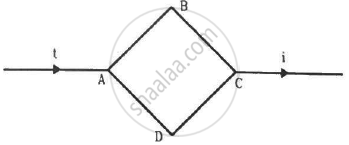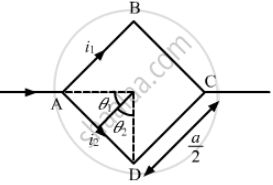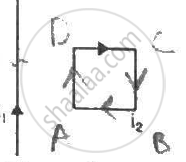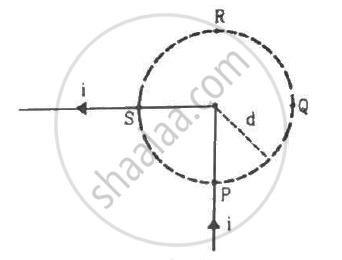Advertisements
Advertisements
Question
Figure shows a square loop ABCD with edge-length a. The resistance of the wire ABC is r and that of ADC is 2r. Find the magnetic field B at the centre of the loop assuming uniform wires.

Solution
Let the currents in wires ABC and ADC be i1 and i2, respectively.
The resistances in wires ABC and ADC are r and 2r, respectively.

\[\therefore \frac{i_1}{i_2} = \frac{2}{1}\]
\[ \Rightarrow i_1 - 2 i_2 = 0 . . . \left( 1 \right)\]
And,
Now,
The magnetic field due to current in wire AD is given by
\[ \Rightarrow B = \frac{\mu_0 \frac{i}{3}}{4\pi\frac{a}{2}}(\sin45 + \sin45)\]
\[B' = 2B = \frac{\mu_0}{4\pi}\frac{i}{3}\frac{a}{a^2} \times 4 \times \sqrt{2}\]
\[ = \frac{\sqrt{2} \mu_0 i}{3\pi a}\]
(Perpendicular to the plane in outward direction)
The magnetic field at centre due to wire ABC is given by
\[B'' = \frac{\mu}{4\pi}\frac{2i}{3}\frac{a}{a^2} \times 4 \times \sqrt{2}\]
\[ = \frac{2\sqrt{2} \mu_0 i}{3\pi a}\]
(Perpendicular to the plane in inward direction)
(Perpendicular to the plane in inward direction)
APPEARS IN
RELATED QUESTIONS
Use Biot-Savart law to derive the expression for the magnetic field on the axis of a current carrying circular loop of radius R.
Draw the magnetic field lines due to a circular wire carrying current I.
Two identical circular coils, P and Q each of radius R, carrying currents 1 A and √3A respectively, are placed concentrically and perpendicular to each other lying in the XY and YZ planes. Find the magnitude and direction of the net magnetic field at the centre of the coils.
Using Biot-Savart law, deduce the expression for the magnetic field at a point (x) on the axis of a circular current carrying loop of radius R. How is the direction of the magnetic field determined at this point?
Derive the expression for the torque on a rectangular current carrying loop suspended in a uniform magnetic field.
A circular loop is kept in that vertical plane which contains the north-south direction. It carries a current that is towards north at the topmost point. Let A be a point on the axis of the circle to the east of it and B a point on this axis to the west of it. The magnetic field due to the loop
Consider the situation shown in figure. The straight wire is fixed but the loop can move under magnetic force. The loop will

A steady electric current is flowing through a cylindrical conductor.
(a) The electric field at the axis of the conductor is zero.
(b) The magnetic field at the axis of the conductor is zero.
(c) The electric field in the vicinity of the conductor is zero.
(d) The magnetic field in the vicinity of the conductor is zero.
Figure shows a long wire bent at the middle to form a right angle. Show that the magnitudes of the magnetic fields at the point P, Q, R and S are equal and find this magnitude.

Two circular coils of radii 5.0 cm and 10 cm carry equal currents of 2.0 A. The coils have 50 and 100 turns respectively and are placed in such a way that their planes as well as the centres coincide. If the outer coil is rotated through 90° about a diameter, Find the magnitude of the magnetic field B at the common centre of the coils if the currents in the coils are (a) in the same sense (b) in the opposite sense.
A circular loop of radius R carries a current I. Another circular loop of radius r(<<R) carries a current i and is placed at the centre of the larger loop. The planes of the two circles are at right angle to each other. Find the torque acting on the smaller loop.
A piece of wire carrying a current of 6.00 A is bent in the form of a circular are of radius 10.0 cm, and it subtends an angle of 120° at the centre. Find the magnetic field B due to this piece of wire at the centre.
A circular loop of radius 4.0 cm is placed in a horizontal plane and carries an electric current of 5.0 A in the clockwise direction as seen from above. Find the magnetic field (a) at a point 3.0 cm above the centre of the loop (b) at a point 3.0 cm below the centre of the loop.
A charged particle moving in a uniform magnetic field and losses 4% of its kinetic energy. The radius of curvature of its path changes by ______.
If ar and at represent radial and tangential accelerations, the motion of the particle will be uniformly circular, if:
An electron is projected along the axis of a circular conductor carrying some current. Electron ______
Two horizontal thin long parallel wires, separated by a distance r carry current I each in the opposite directions. The net magnetic field at a point midway between them will be ______.
